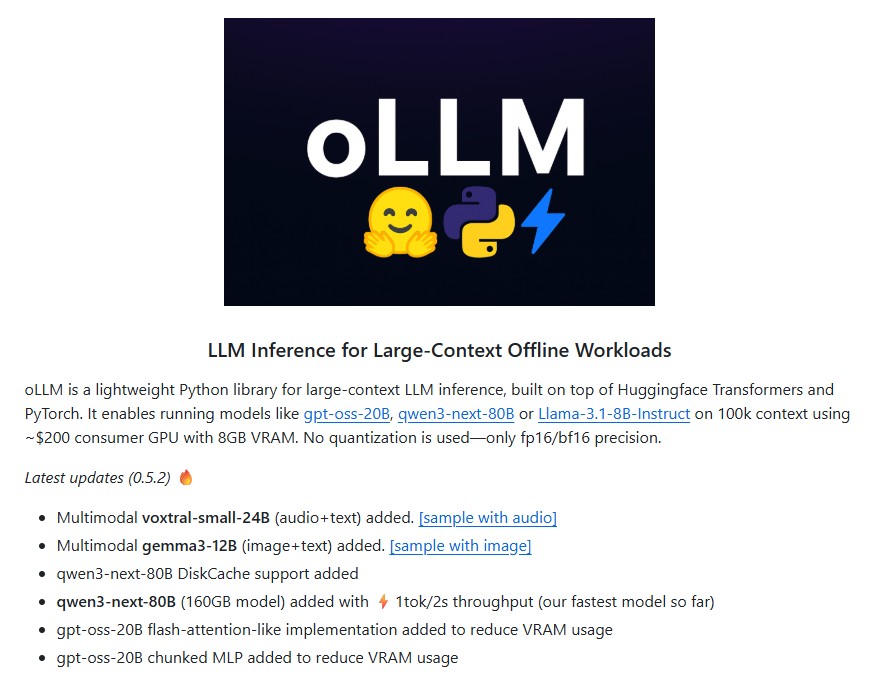Artificial intelligence has revolutionized the way we process information, analyze data, and automate complex tasks. With the rise of large language models (LLMs), AI capabilities have grown exponentially, enabling applications from natural language understanding to multimodal reasoning. However, running these models efficiently especially with massive context windows, remains a challenge due to their high memory and computational requirements.

In this blog, we explore oLLM, a lightweight Python library that enables large-context LLM inference on consumer-grade GPUs making high-performance AI accessible to a wider audience.
What is oLLM?
It is a Python library built on top of Huggingface Transformers and PyTorch. It allows developers and researchers to run large-scale LLMs efficiently, even on GPUs with limited VRAM such as an 8GB Nvidia 3060 Ti. Models like gpt-oss-20B, qwen3-next-80B and Llama-3.1-8B-Instruct are supported, allowing context lengths up to 100,000 tokens.
Unlike traditional approaches that require expensive hardware or aggressive quantization, it leverages advanced techniques like SSD-based weight streaming, KV cache offloading and chunked MLPs to dramatically reduce GPU memory usage.
Key Features
Some of the standout features include:
- Multimodal Capabilities: It supports
voxtral-small-24Bfor audio+text andgemma3-12Bfor image+text processing, enabling seamless AI inference across multiple data types. - Efficient Memory Management: By offloading KV caches and model layers to SSD or CPU, it significantly reduces GPU VRAM usage. For example,
qwen3-next-80B, which normally requires ~190 GB of VRAM can run on an 8GB GPU with oLLM. - High-Performance Throughput: FlashAttention and chunked MLP implementations accelerate inference without materializing large attention matrices.
- Scalability: Supports extremely long contexts of up to 100,000 tokens, ideal for analyzing large datasets, logs, medical records or legal documents in one pass.
How oLLM Works ?
It achieves its efficiency through smart memory and computation management:
- Layer-by-Layer Weight Loading: Weights are streamed directly from SSD to GPU as needed avoiding loading the entire model into VRAM.
- KV Cache Offloading: Context-dependent key-value caches are offloaded to SSD and reloaded dynamically, enabling extremely long context processing.
- CPU Layer Offloading: Some layers can be optionally offloaded to CPU memory to free GPU resources for faster computations.
- FlashAttention Implementation: Full attention matrices are never materialized reducing memory overhead while maintaining speed.
- Chunked MLP: Large intermediate layers are split into chunks to manage memory effectively.
These optimizations allow even massive models like qwen3-next-80B or gpt-oss-20B to run smoothly on consumer hardware.
Explore here : Github Link
Use Cases
It empowers developers, data scientists and researchers with high-performance LLM capabilities. Popular use cases include:
- Legal and Compliance Analysis: Quickly process large contracts, regulations or compliance documents to extract insights.
- Healthcare and Medical Research: Analyze patient histories, medical literature and research papers efficiently.
- Log Analysis and Cybersecurity: Process extensive server logs or threat reports locally without cloud infrastructure.
- Customer Support Analysis: Analyze historical chat logs to identify frequent user issues and improve service quality.
- Multimodal Content Processing: Process audio and image data alongside text for advanced AI applications.
Supported Hardware
It is compatible with Nvidia GPUs including Ampere (RTX 30xx), Ada Lovelace (RTX 40xx) and Hopper (H100). Even mid-range GPUs with 8GB VRAM can run large models efficiently making oLLM highly accessible.
Getting Started
Setting up oLLM is straightforward:
- Create a Virtual Environment:
python3 -m venv ollm_env source ollm_env/bin/activate
- Install oLLM:
git clone https://github.com/Mega4alik/ollm.git cd ollm pip install -e . pip install kvikio-cu12 # Example for CUDA 12
- Run a Sample Model:
from ollm import Inference, TextStreamer
o = Inference("llama3-1B-chat", device="cuda:0", logging=True)
o.ini_model(models_dir="./models/")
text_streamer = TextStreamer(o.tokenizer)
messages = [
{"role": "system", "content": "You are a helpful AI assistant"},
{"role": "user", "content": "List planets"}
]
input_ids = o.tokenizer.apply_chat_template(
messages, reasoning_effort="minimal", tokenize=True, add_generation_prompt=True, return_tensors="pt"
).to(o.device)
outputs = o.model.generate(
input_ids=input_ids, past_key_values=None, max_new_tokens=500, streamer=text_streamer
).cpu()
answer = o.tokenizer.decode(outputs[0][input_ids.shape[-1]:])
print(answer)
With this simple setup, you can start integrating LLMs into your projects immediately.
Roadmap and Future Developments
The oLLM roadmap includes:
- Quantized versions of Qwen3-Next for even lower memory usage.
- Multimodal vision-language models (Qwen3-VL) for advanced image-text reasoning.
- Multi-token prediction for improved AI performance in complex tasks.
Community feedback and model suggestions are encouraged, making oLLM a growing platform for cutting-edge AI research.
Conclusion
In this blog, we explored how oLLM is transforming the landscape of large-context LLM inference. By leveraging SSD streaming, KV cache offloading, flash attention and chunked MLP, it enables developers to run massive AI models efficiently on consumer GPUs. Whether you are analyzing medical literature, legal documents, logs, or multimodal content, it provides a flexible and high-performance solution for modern AI workloads.
By democratizing access to large-scale AI inference, it opens doors for innovation across research, business, and technology allowing more people to harness the true potential of AI.
Follow us for cutting-edge updates in AI & explore the world of LLMs, deep learning, NLP and AI agents with us.
Related Reads
- Gamma PPT AI : Unlock Presentations in Minutes
- PyMuPDF: The Ultimate Python Library for High-Performance PDF Processing
- Ling-1T by inclusionAI: The Future of Smarter, Faster and More Efficient AI Models
- OpenAI’s AgentKit: Transforming How Developers Build and Deploy AI Agents
- Build a Large Language Model From Scratch: A Step-by-Step Guide to Understanding and Creating LLMs

5 thoughts on “How oLLM Makes Large-Context AI Models Run Smoothly on 8GB GPUs”